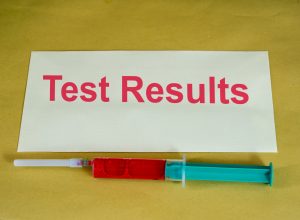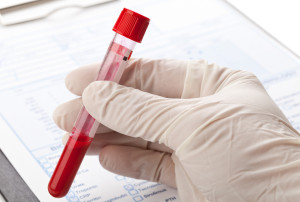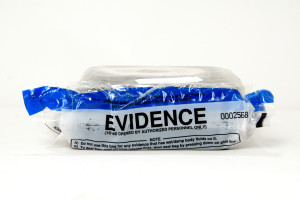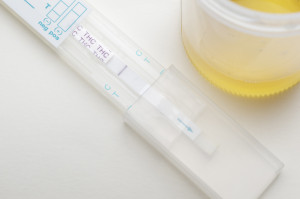 Joe was arrested for DUI / OVI, and the officer had Joe take a breath test and a urine test. The breath test showed an alcohol level under Ohio’s limit, and the urine test showed an alcohol level over Ohio’s limit. Based on the urine test result, Joe was prosecuted for operating a vehicle with a prohibited concentration of alcohol in his system. Should Joe be found guilty of OVI?
Joe was arrested for DUI / OVI, and the officer had Joe take a breath test and a urine test. The breath test showed an alcohol level under Ohio’s limit, and the urine test showed an alcohol level over Ohio’s limit. Based on the urine test result, Joe was prosecuted for operating a vehicle with a prohibited concentration of alcohol in his system. Should Joe be found guilty of OVI?
Articles Posted in DUI/OVI blood/breath/urine tests
Breath Alcohol Tester From ‘Shark Tank’ Settles FTC Complaint
 A smartphone app for breath-alcohol-testing was so promising that all five investors on Shark Tank collaborated on a deal for the first time. In 2013, Charles Yim went on the show and pitched his app to the Sharks. The Sharks collectively invested $1 million in Yim’s company Breathometer, Inc. for 30% of the company’s equity. Three years later, the company was the subject of an FTC complaint, and the complaint was recently settled.
A smartphone app for breath-alcohol-testing was so promising that all five investors on Shark Tank collaborated on a deal for the first time. In 2013, Charles Yim went on the show and pitched his app to the Sharks. The Sharks collectively invested $1 million in Yim’s company Breathometer, Inc. for 30% of the company’s equity. Three years later, the company was the subject of an FTC complaint, and the complaint was recently settled.
Calibrating Breath Testing Machines In Ohio DUI/OVI Cases
 Over 20,000 DWI cases in New Jersey are being called into question due to problems with the recalibration of breath-testing machines. According to New Jersey 101.5, Sgt. Marc Dennis skipped a critical step each time he recalibrated the machines. Plaintiffs in a class-action lawsuit now seek to vacate thousands of convictions in which evidence was produced by those breath-testing machines. Although this debacle occurred in New Jersey, it illustrates the importance of properly maintaining breath-testing machines in Ohio DUI/OVI cases.
Over 20,000 DWI cases in New Jersey are being called into question due to problems with the recalibration of breath-testing machines. According to New Jersey 101.5, Sgt. Marc Dennis skipped a critical step each time he recalibrated the machines. Plaintiffs in a class-action lawsuit now seek to vacate thousands of convictions in which evidence was produced by those breath-testing machines. Although this debacle occurred in New Jersey, it illustrates the importance of properly maintaining breath-testing machines in Ohio DUI/OVI cases.
Can We Trust Crime Lab Results In Ohio DUI/OVI Cases?
 Today’s report regarding the conduct of a forensic scientist employed by the state of Ohio demonstrates the danger of the government enforcing laws without effective checks and balances. Forensic scientist G. Michele Yezzo worked for over 30 years as a laboratory technician for the Ohio Bureau of Criminal Investigation (BCI). During that time, she analyzed evidence in criminal cases and testified in court regarding those analyses. The feature story in The Columbus Dispatch says she now, “stands accused of slanting evidence to help cops and prosecutors build their cases.”
Today’s report regarding the conduct of a forensic scientist employed by the state of Ohio demonstrates the danger of the government enforcing laws without effective checks and balances. Forensic scientist G. Michele Yezzo worked for over 30 years as a laboratory technician for the Ohio Bureau of Criminal Investigation (BCI). During that time, she analyzed evidence in criminal cases and testified in court regarding those analyses. The feature story in The Columbus Dispatch says she now, “stands accused of slanting evidence to help cops and prosecutors build their cases.”
U.S. Supreme Court Decides Constitutionality Of Warrantless Blood Tests And Breath Tests In DUI Cases
 Last week, the United States Supreme Court released a decision in a trio of cases involving DUI refusal laws. A previous article in this blog gives a preview of the cases. To decide the outcomes of those cases, the court analyzes whether search warrants are required before law enforcement officers can administer breath tests and blood tests. Based on that analysis, the Court decides whether states can make it illegal to refuse chemical tests in DUI cases. The Court’s decision will impact Ohio DUI/OVI cases.
Last week, the United States Supreme Court released a decision in a trio of cases involving DUI refusal laws. A previous article in this blog gives a preview of the cases. To decide the outcomes of those cases, the court analyzes whether search warrants are required before law enforcement officers can administer breath tests and blood tests. Based on that analysis, the Court decides whether states can make it illegal to refuse chemical tests in DUI cases. The Court’s decision will impact Ohio DUI/OVI cases.
Ohio DUI/OVI Refusal Law May Be Affected By Cases In U.S. Supreme Court
 Suppose a police officer comes to your home tonight without a warrant and wants you to consent to a search of your residence. If you are like most people, you would say ‘no’: you would assert your Fourth Amendment right to be free from unreasonable searches and seizures. Now suppose the government makes it a crime for you to refuse to consent to the search. That’s what Ohio and several other states have done with DUI laws which criminalize refusing a breath/blood/urine test. Those laws are the subject of cases currently before the United States Supreme Court.
Suppose a police officer comes to your home tonight without a warrant and wants you to consent to a search of your residence. If you are like most people, you would say ‘no’: you would assert your Fourth Amendment right to be free from unreasonable searches and seizures. Now suppose the government makes it a crime for you to refuse to consent to the search. That’s what Ohio and several other states have done with DUI laws which criminalize refusing a breath/blood/urine test. Those laws are the subject of cases currently before the United States Supreme Court.
Person Medically Incapable Of Urinating Is Not ‘Refusing’ The Test
 A judge in Columbus, Ohio found a man to be in violation of probation because the man was unable to urinate upon request. The judge was aware the defendant, Mr. Hand, had medical problems which caused urinary difficulties and was taking medication designed to increase his urination. Nevertheless, the judge concluded Mr. Hand’s inability to urinate constituted a “refusal” to submit to a urine test. Individuals placed on probation for DUI/OVI in Ohio do not have this kind of experience, ordinarily. But this was no ordinary case.
A judge in Columbus, Ohio found a man to be in violation of probation because the man was unable to urinate upon request. The judge was aware the defendant, Mr. Hand, had medical problems which caused urinary difficulties and was taking medication designed to increase his urination. Nevertheless, the judge concluded Mr. Hand’s inability to urinate constituted a “refusal” to submit to a urine test. Individuals placed on probation for DUI/OVI in Ohio do not have this kind of experience, ordinarily. But this was no ordinary case.
Refrigerating Blood And Urine Samples In Ohio DUI/OVI Cases
 When a person is arrested for DUI/OVI in Ohio, the arresting officer typically asks the person to submit to a breath, blood or urine test. For a test result to be admissible in court, the test must be administered in compliance with regulations issued by the Ohio Department of Health. One regulation requires refrigeration of blood and urine samples, and that regulation was the subject of a recent case decided by the Ohio Supreme Court.
When a person is arrested for DUI/OVI in Ohio, the arresting officer typically asks the person to submit to a breath, blood or urine test. For a test result to be admissible in court, the test must be administered in compliance with regulations issued by the Ohio Department of Health. One regulation requires refrigeration of blood and urine samples, and that regulation was the subject of a recent case decided by the Ohio Supreme Court.
The Speedy Trial Clock In Ohio DUI/OVI Cases With Blood Or Urine Tests
 Four months after Brittany was arrested and charged with OVI, the government charged her with a second count of OVI. In November, Brittany was arrested for OVI. On the day of her arrest, she submitted a urine sample, and she was charged with OVI. Three weeks later, the urine sample was analyzed, and the result was provided to the police department. In March, four months after the arrest, the police department charged Brittany with a second count of OVI based on the result of the urine test. Isn’t that a violation of her right to a speedy trial?
Four months after Brittany was arrested and charged with OVI, the government charged her with a second count of OVI. In November, Brittany was arrested for OVI. On the day of her arrest, she submitted a urine sample, and she was charged with OVI. Three weeks later, the urine sample was analyzed, and the result was provided to the police department. In March, four months after the arrest, the police department charged Brittany with a second count of OVI based on the result of the urine test. Isn’t that a violation of her right to a speedy trial?
Marijuana Metabolism And Ohio’s DUI/OVI Laws
 Next week, Ohioans will vote on Issue 3: a state constitutional amendment to legalize marijuana for medicinal and personal use*. If marijuana use is legalized in Ohio, more drivers will face charges of operating a vehicle under the influence of marijuana. Ohio’s OVI-marijuana laws raise many questions: How long does a marijuana high last? Does marijuana impair driving ability? Do blood and urine test results correlate with impaired driving ability? Are Ohio’s OVI-marijuana laws Constitutional? This article addresses the first question by discussing the duration of marijuana effects.
Next week, Ohioans will vote on Issue 3: a state constitutional amendment to legalize marijuana for medicinal and personal use*. If marijuana use is legalized in Ohio, more drivers will face charges of operating a vehicle under the influence of marijuana. Ohio’s OVI-marijuana laws raise many questions: How long does a marijuana high last? Does marijuana impair driving ability? Do blood and urine test results correlate with impaired driving ability? Are Ohio’s OVI-marijuana laws Constitutional? This article addresses the first question by discussing the duration of marijuana effects.
 Columbus OVI/DUI Attorney Blog
Columbus OVI/DUI Attorney Blog

